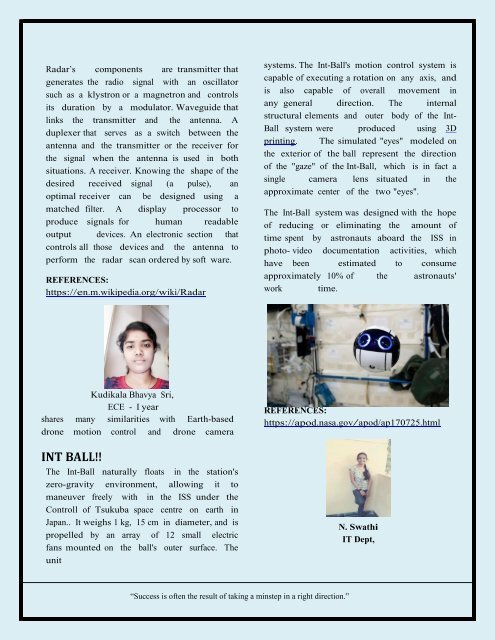Create successful ePaper yourself
Turn your PDF publications into a flip-book with our unique Google optimized e-Paper software.
Radar’s components are transmitter that<br />
generates the radio signal with an oscillator<br />
such as a klystron or a magnetron and controls<br />
its duration by a modulator. Waveguide that<br />
links the transmitter and the antenna. A<br />
duplexer that serves as a switch between the<br />
antenna and the transmitter or the receiver for<br />
the signal when the antenna is used in both<br />
situations. A receiver. Knowing the shape of the<br />
desired received signal (a pulse), an<br />
optimal receiver can be designed using a<br />
matched filter. A display processor to<br />
produce signals for human readable<br />
output devices. An electronic section that<br />
controls all those devices and the antenna to<br />
perform the radar scan ordered by soft ware.<br />
REFERENCES:<br />
https://en.m.wikipedia.org/wiki/Radar<br />
systems. The Int-Ball's motion control system is<br />
capable of executing a rotation on any axis, and<br />
is also capable of overall movement in<br />
any general direction. The internal<br />
structural elements and outer body of the Int-<br />
Ball system were produced using 3D<br />
printing. The simulated "eyes" modeled on<br />
the exterior of the ball represent the direction<br />
of the "gaze" of the Int-Ball, which is in fact a<br />
single camera lens situated in the<br />
approximate center of the two "eyes".<br />
The Int-Ball system was designed with the hope<br />
of reducing or eliminating the amount of<br />
time spent by astronauts aboard the ISS in<br />
photo- video documentation activities, which<br />
have been estimated to consume<br />
approximately 10% of the astronauts'<br />
work time.<br />
Kudikala Bhavya Sri,<br />
ECE - I year<br />
shares many similarities with Earth-based<br />
drone motion control and drone camera<br />
REFERENCES:<br />
https://apod.nasa.gov/apod/ap170725.html<br />
INT BALL!!<br />
The Int-Ball naturally floats<br />
in the station's<br />
zero-gravity environment, allowing it to<br />
maneuver freely with in the ISS under the<br />
Controll of Tsukuba space centre on earth in<br />
Japan.. It weighs 1 kg, 15 cm in diameter, and is<br />
propelled by an array of 12 small electric<br />
fans mounted on the ball's outer surface. The<br />
unit<br />
N. Swathi<br />
IT Dept,<br />
“Success is often the result of taking a minstep in a right direction.”





